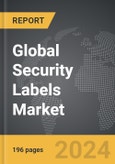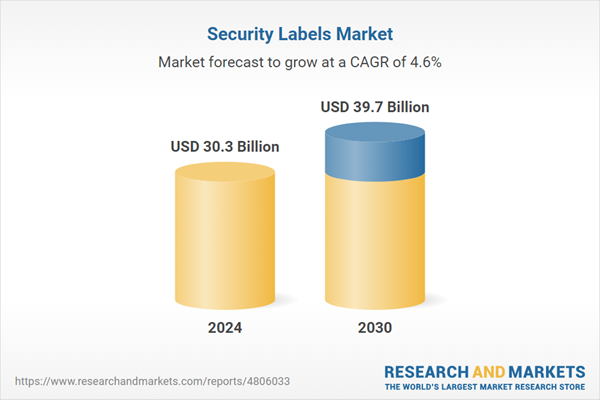The global market for Security Labels was valued at USD 30.3 Billion in 2024 and is projected to reach USD 39.7 Billion by 2030, growing at a CAGR of 4.6% from 2024 to 2030. This comprehensive report provides an in-depth analysis of market trends, drivers, and forecasts, helping you make informed business decisions.
Global Security Labels Market - Key Trends and Drivers Summarized
Why Are Security Labels Essential in Combating Counterfeiting and Fraud?
Security labels are critical components in the fight against counterfeiting, product tampering, and fraud, providing a vital layer of protection for brands, consumers, and supply chains. These labels are designed with advanced security features such as holograms, QR codes, tamper-evident seals, RFID tags, and watermarks, making it difficult for counterfeiters to replicate them. With the rapid growth of e-commerce and globalization of supply chains, the risk of counterfeit products has surged, especially in industries like pharmaceuticals, food and beverages, electronics, cosmetics, and luxury goods. Security labels serve as a first line of defense by authenticating products, ensuring their integrity, and preventing unauthorized tampering. The increasing awareness among consumers about product safety and quality is driving the adoption of security labels across various sectors. Companies are investing in sophisticated security label solutions to protect their brand reputation and build trust among their customers.What Technological Innovations Are Transforming Security Labels?
Technological advancements are revolutionizing the security labels market, making them more effective, versatile, and integrated with digital solutions. The development of RFID and NFC-enabled security labels is providing real-time tracking and traceability, enhancing supply chain transparency and inventory management. Smart labels embedded with digital watermarks and blockchain technology are gaining traction, enabling end-to-end product authentication and enhancing consumer engagement through interactive features. Holographic labels, with multiple layers of security and optical elements, are being used extensively in high-value products to prevent counterfeiting. Moreover, the shift towards eco-friendly and sustainable security labels made from biodegradable materials is gaining momentum as companies look to reduce their environmental footprint. These innovations are expanding the applications of security labels, making them more robust, adaptive, and aligned with the evolving needs of various industries.Which Market Segments Are Leading the Adoption of Security Labels?
The security labels market is segmented by product type, technology, application, end-use industry, and region. Product types include holographic labels, barcode labels, RFID labels, and tamper-evident labels, each serving different security needs and applications. In terms of technology, tamper-evident and RFID labels are seeing high adoption due to their effectiveness in ensuring product integrity and enabling real-time tracking. End-use industries such as pharmaceuticals, food and beverages, cosmetics, electronics, and automotive are major adopters of security labels due to the critical need for brand protection and compliance with regulatory standards. The pharmaceutical sector, in particular, is a significant user of security labels to prevent drug counterfeiting and ensure patient safety. Geographically, North America and Europe dominate the security labels market due to stringent regulations and high awareness of anti-counterfeiting measures. However, the Asia-Pacific region is emerging as a high-growth market driven by increasing manufacturing activities and rising incidences of counterfeiting.What Are the Key Drivers of Growth in the Security Labels Market?
The growth in the security labels market is driven by several factors, including the rising demand for anti-counterfeiting solutions, technological advancements in smart labels, and the increasing focus on sustainability. The growing e-commerce sector and the globalization of supply chains are fueling the demand for security labels to ensure product authenticity and prevent tampering. The integration of RFID, NFC, and blockchain technologies in security labels is enhancing traceability and providing real-time visibility into the supply chain, driving their adoption across various industries. The focus on eco-friendly and sustainable security labels is gaining prominence, driven by consumer demand for green products and regulatory requirements for sustainable packaging. Additionally, the expansion of applications in high-growth sectors such as pharmaceuticals, food and beverages, and electronics is further supporting market growth.Report Scope
The report analyzes the Security Labels market, presented in terms of market value (USD Thousand). The analysis covers the key segments and geographic regions outlined below.Segments
Identification Method (Bar Codes, Holographic, Radio Frequency Identification); Form (Sheets, Reels); Application (Food & Beverage, Retail, Consumer Durables, Pharmaceuticals, Other Applications).Geographic Regions/Countries
World; United States; Canada; Japan; China; Europe (France; Germany; Italy; United Kingdom; and Rest of Europe); Asia-Pacific; Rest of World.Key Insights:
- Market Growth: Understand the significant growth trajectory of the Bar Codes Identification segment, which is expected to reach $29.5 Billion by 2030 with a CAGR of a 5%. The Holographic Identification segment is also set to grow at 3.8% CAGR over the analysis period.
- Regional Analysis: Gain insights into the U.S. market, valued at $8.2 Billion in 2024, and China, forecasted to grow at an impressive 4.2% CAGR to reach $6.2 Billion by 2030. Discover growth trends in other key regions, including Japan, Canada, Germany, and the Asia-Pacific.
Report Features:
- Comprehensive Market Data: Independent analysis of annual sales and market forecasts in USD from 2024 to 2030.
- In-Depth Regional Analysis: Detailed insights into key markets, including the U.S., China, Japan, Canada, Europe, Asia-Pacific, Latin America, Middle East, and Africa.
- Company Profiles: Coverage of major players such as 3M Company, Avery Dennison Corporation, CCL Industries, Inc., GroupDC, Honeywell International, Inc. and more.
- Complimentary Updates: Receive free report updates for one year to keep you informed of the latest market developments.
Why You Should Buy This Report:
- Detailed Market Analysis: Access a thorough analysis of the Global Security Labels Market, covering all major geographic regions and market segments.
- Competitive Insights: Get an overview of the competitive landscape, including the market presence of major players across different geographies.
- Future Trends and Drivers: Understand the key trends and drivers shaping the future of the Global Security Labels Market.
- Actionable Insights: Benefit from actionable insights that can help you identify new revenue opportunities and make strategic business decisions.
Key Questions Answered:
- How is the Global Security Labels Market expected to evolve by 2030?
- What are the main drivers and restraints affecting the market?
- Which market segments will grow the most over the forecast period?
- How will market shares for different regions and segments change by 2030?
- Who are the leading players in the market, and what are their prospects?
Some of the 46 major companies featured in this Security Labels market report include:
- 3M Company
- Avery Dennison Corporation
- CCL Industries, Inc.
- GroupDC
- Honeywell International, Inc.
- Label Lock
- Polylabel.com, Inc.
- Seiko Holdings Corporation
- Tesa SE
- UPM
Table of Contents
I. METHODOLOGYII. EXECUTIVE SUMMARY2. FOCUS ON SELECT PLAYERSIII. MARKET ANALYSISCANADAITALYREST OF EUROPEREST OF WORLDIV. COMPETITION
1. MARKET OVERVIEW
3. MARKET TRENDS & DRIVERS
4. GLOBAL MARKET PERSPECTIVE
UNITED STATES
JAPAN
CHINA
EUROPE
FRANCE
GERMANY
UNITED KINGDOM
ASIA-PACIFIC
Companies Mentioned (Partial List)
A selection of companies mentioned in this report includes, but is not limited to:
- 3M Company
- Avery Dennison Corporation
- CCL Industries, Inc.
- GroupDC
- Honeywell International, Inc.
- Label Lock
- Polylabel.com, Inc.
- Seiko Holdings Corporation
- Tesa SE
- UPM
Table Information
| Report Attribute | Details |
|---|---|
| No. of Pages | 196 |
| Published | April 2025 |
| Forecast Period | 2024 - 2030 |
| Estimated Market Value ( USD | $ 30.3 Billion |
| Forecasted Market Value ( USD | $ 39.7 Billion |
| Compound Annual Growth Rate | 4.6% |
| Regions Covered | Global |









